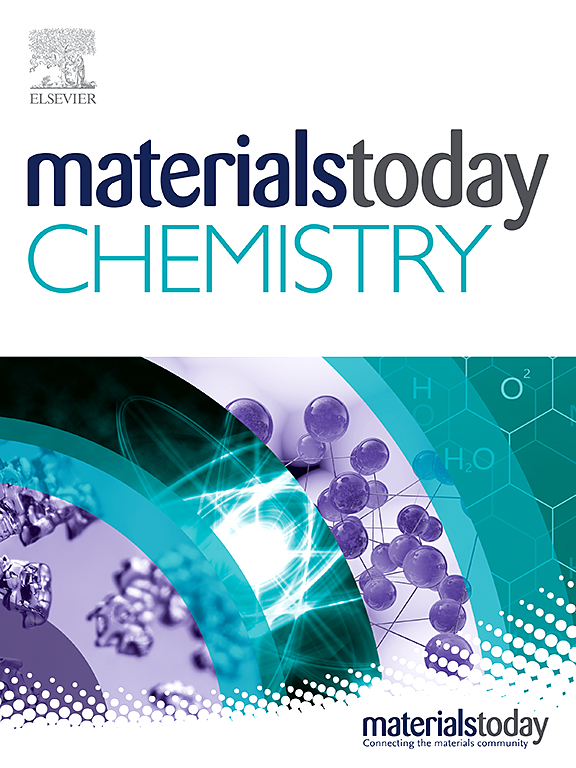化学结构和环境因素对聚酰亚胺热降解机理的影响:实验和分子动力学模拟
IF 6.7
2区 化学
Q1 CHEMISTRY, MULTIDISCIPLINARY
引用次数: 0
摘要
通过实验和分子模拟相结合的方法,研究了化学结构和环境对聚酰亚胺(PI)热稳定性的影响,并确定了降解机制。机械性能的变化和热重分析(TGA)被用来表征聚酰亚胺的热稳定性。热解气相色谱质谱法(Py-GCMS)和热重-红外光谱法(TG-IR)用于定性和定量分析降解产物。采用分子模拟分析了 PI 的主键断裂和热降解途径,并研究了化学结构、气氛和温度对降解特性的影响。研究结果表明,对苯结构的 3,3′,4,4′-联苯四羧酸二酐(BPDA)/苯二胺(PDA)具有最好的热稳定性,而 4,4′-氧二苯胺(ODA)中的 C-O-C 和 2-(4-氨基苯基)-1H-苯并咪唑-5-胺(BIA)咪唑基团中的 C-N 等弱键则会降低热稳定性。提出了 PI 的低分子量产物(CO、CO、HCN 和 NH)的形成路径和潜在降解机制。在原子水平上观察到氧气和高温加速了 PI 的热降解过程。综上所述,这项工作为实时监测 PI 降解过程的结构演变提供了可能。本文章由计算机程序翻译,如有差异,请以英文原文为准。
Effect of chemical structures and environmental factors on the thermal degradation mechanism of polyimide: Experiments and molecular dynamics simulations
The impact of chemical structure and environment on the thermal stability of polyimide (PI) was examined, and the degradation mechanism was determined using a combination of experiments and molecular simulations. Changes in mechanical properties and thermogravimetric analysis (TGA) were used to characterize the thermal stability of PI. Pyrolysis gas chromatography mass spectrometry (Py-GCMS) and thermogravimetric-infrared spectroscopy (TG-IR) were used to analyze the degradation products both qualitatively and quantitatively. Molecular simulation was employed to analyze the primary bond breakage and thermal degradation pathways of PI, as well as to investigate the effects of the chemical structure, atmosphere, and temperature on degradation properties. The findings indicated that p-benzene-structured 3,3′,4,4′-biphenyltetracarboxylic dianhydride (BPDA)/-phenylenediamine (PDA) has the best thermal stability, whereas weak bonds like C–O–C in 4,4′-oxydianiline (ODA) and C–N in the 2-(4-aminophenyl)-1H-benzimidazol-5-amine (BIA) imidazole group decrease thermal stability. The formation path of low molecular weight products (CO, CO, HCN, and NH) and the potential degradation mechanism of PI were proposed. The process of PI thermal degradation accelerated by oxygen and high temperature was observed at the atomic level. Taken together, this work offers the possibility of monitoring the structural evolution of PI degradation process in real-time.
求助全文
通过发布文献求助,成功后即可免费获取论文全文。
去求助
来源期刊

Materials Today Chemistry
Multiple-
CiteScore
8.90
自引率
6.80%
发文量
596
审稿时长
33 days
期刊介绍:
Materials Today Chemistry is a multi-disciplinary journal dedicated to all facets of materials chemistry.
This field represents one of the fastest-growing areas of science, involving the application of chemistry-based techniques to the study of materials. It encompasses materials synthesis and behavior, as well as the intricate relationships between material structure and properties at the atomic and molecular scale. Materials Today Chemistry serves as a high-impact platform for discussing research that propels the field forward through groundbreaking discoveries and innovative techniques.
 求助内容:
求助内容: 应助结果提醒方式:
应助结果提醒方式:


